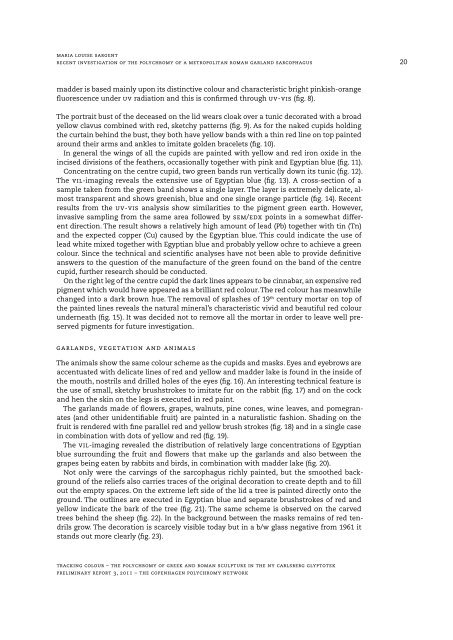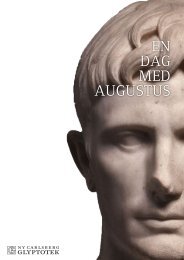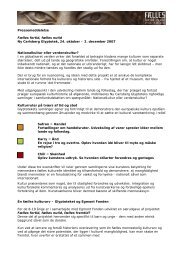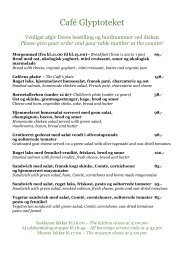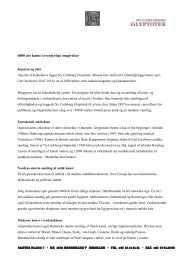Preliminary Report 3, 2011 - Ny Carlsberg Glyptotek
Preliminary Report 3, 2011 - Ny Carlsberg Glyptotek
Preliminary Report 3, 2011 - Ny Carlsberg Glyptotek
Create successful ePaper yourself
Turn your PDF publications into a flip-book with our unique Google optimized e-Paper software.
Maria Louise Sargent<br />
Recent Investigation of the Polychromy of a Metropolitan Roman Garland Sarcophagus<br />
20<br />
madder is based mainly upon its distinctive colour and characteristic bright pinkish-orange<br />
fluorescence under UV radiation and this is confirmed through UV-VIS (fig. 8).<br />
The portrait bust of the deceased on the lid wears cloak over a tunic decorated with a broad<br />
yellow clavus combined with red, sketchy patterns (fig. 9). As for the naked cupids holding<br />
the curtain behind the bust, they both have yellow bands with a thin red line on top painted<br />
around their arms and ankles to imitate golden bracelets (fig. 10).<br />
In general the wings of all the cupids are painted with yellow and red iron oxide in the<br />
incised divisions of the feathers, occasionally together with pink and Egyptian blue (fig. 11).<br />
Concentrating on the centre cupid, two green bands run vertically down its tunic (fig. 12).<br />
The VIL-imaging reveals the extensive use of Egyptian blue (fig. 13). A cross-section of a<br />
sample taken from the green band shows a single layer. The layer is extremely delicate, almost<br />
transparent and shows greenish, blue and one single orange particle (fig. 14). Recent<br />
results from the UV-VIS analysis show similarities to the pigment green earth. However,<br />
invasive sampling from the same area followed by SEM/EDX points in a somewhat different<br />
direction. The result shows a relatively high amount of lead (Pb) together with tin (Tn)<br />
and the expected copper (Cu) caused by the Egyptian blue. This could indicate the use of<br />
lead white mixed together with Egyptian blue and probably yellow ochre to achieve a green<br />
colour. Since the technical and scientific analyses have not been able to provide definitive<br />
answers to the question of the manufacture of the green found on the band of the centre<br />
cupid, further research should be conducted.<br />
On the right leg of the centre cupid the dark lines appears to be cinnabar, an expensive red<br />
pigment which would have appeared as a brilliant red colour. The red colour has meanwhile<br />
changed into a dark brown hue. The removal of splashes of 19 th century mortar on top of<br />
the painted lines reveals the natural mineral’s characteristic vivid and beautiful red colour<br />
underneath (fig. 15). It was decided not to remove all the mortar in order to leave well preserved<br />
pigments for future investigation.<br />
Garlands, vegetation and animals<br />
The animals show the same colour scheme as the cupids and masks. Eyes and eyebrows are<br />
accentuated with delicate lines of red and yellow and madder lake is found in the inside of<br />
the mouth, nostrils and drilled holes of the eyes (fig. 16). An interesting technical feature is<br />
the use of small, sketchy brushstrokes to imitate fur on the rabbit (fig. 17) and on the cock<br />
and hen the skin on the legs is executed in red paint.<br />
The garlands made of flowers, grapes, walnuts, pine cones, wine leaves, and pomegranates<br />
(and other unidentifiable fruit) are painted in a naturalistic fashion. Shading on the<br />
fruit is rendered with fine parallel red and yellow brush strokes (fig. 18) and in a single case<br />
in combination with dots of yellow and red (fig. 19).<br />
The VIL-imaging revealed the distribution of relatively large concentrations of Egyptian<br />
blue surrounding the fruit and flowers that make up the garlands and also between the<br />
grapes being eaten by rabbits and birds, in combination with madder lake (fig. 20).<br />
Not only were the carvings of the sarcophagus richly painted, but the smoothed background<br />
of the reliefs also carries traces of the original decoration to create depth and to fill<br />
out the empty spaces. On the extreme left side of the lid a tree is painted directly onto the<br />
ground. The outlines are executed in Egyptian blue and separate brushstrokes of red and<br />
yellow indicate the bark of the tree (fig. 21). The same scheme is observed on the carved<br />
trees behind the sheep (fig. 22). In the background between the masks remains of red tendrils<br />
grow. The decoration is scarcely visible today but in a b/w glass negative from 1961 it<br />
stands out more clearly (fig. 23).<br />
tracking colour – The polychromy of Greek and Roman sculpture in the <strong>Ny</strong> <strong>Carlsberg</strong> <strong>Glyptotek</strong><br />
<strong>Preliminary</strong> <strong>Report</strong> 3, <strong>2011</strong> – the copenhagen polychromy network


